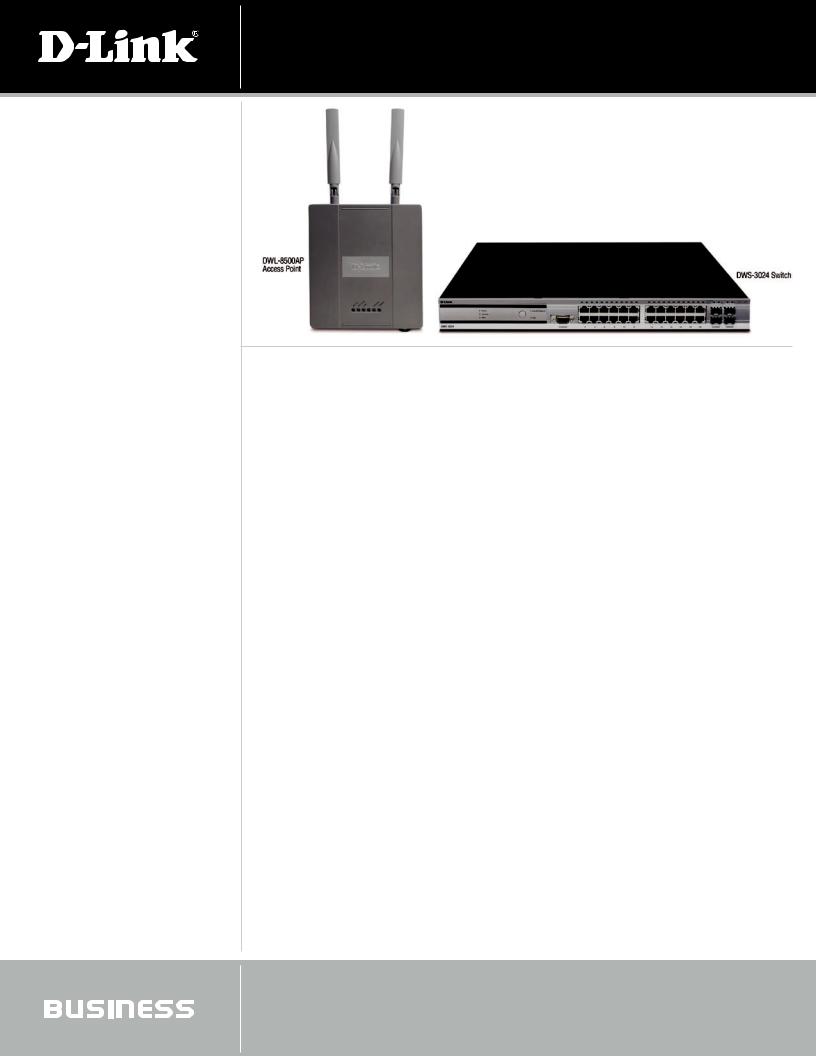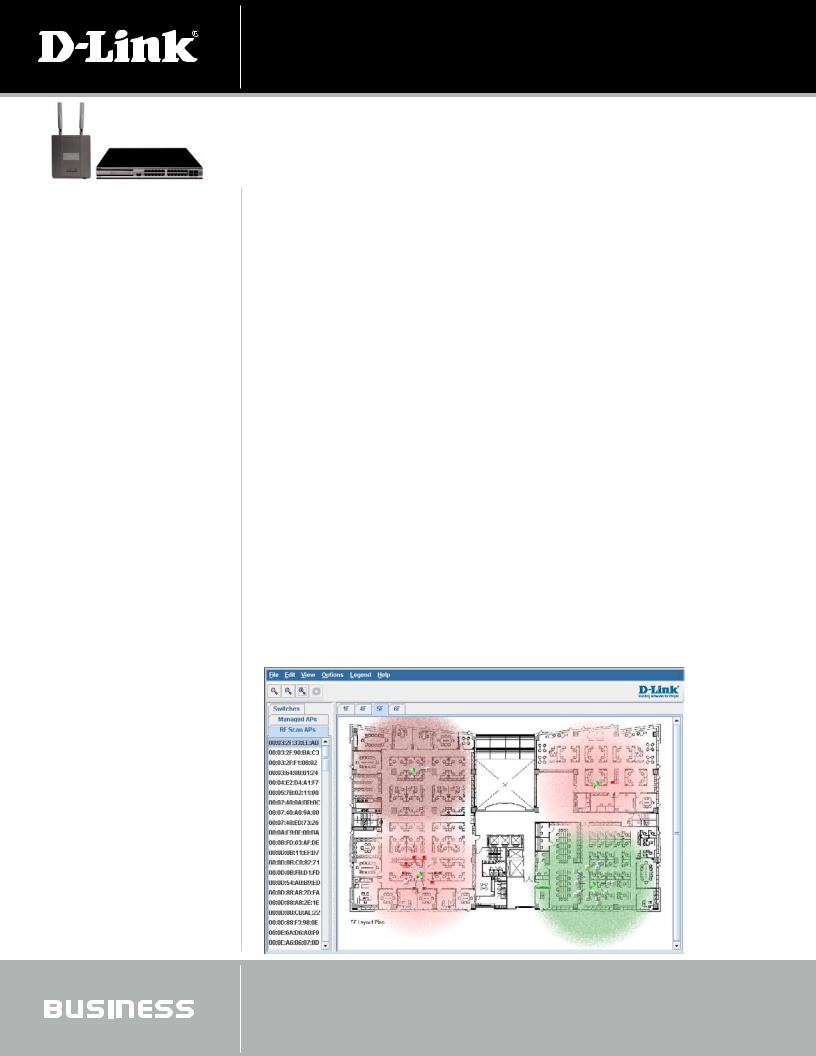D-Link DWS-3024, DWL-8500AP User Manual

Centralized Management of
Wireless Network
+Tracks and Maintains User Authentication as Users Roam throughout the Network
+Intelligently Designates Users to Virtual Groups Based on User’s Authenticated Identity
+Provides Scaled, Resilient, Integrated Management Infrastructure
+Centrally Manages User Authentication/Security Policies
+Provides Key Management for Each Security Protocol
+Configures and Controls All Connected Access Points
Simplified & Resilient Network
Deployment
+802.3af Power Over Ethernet Simplifies AP Installation
+Gigabit Connection Ready for Future Wireless Speed Upgrade
+Redundant Power Supply Support Maximizes Network Uptime
+Auto-Healing Around Failed Access Points Ensures Coverage Integrity
Unified
+Provides Centralized Security/ Management for WLAN Infrastructure
+Provides 802.3af PoE, Auto-Adjustment of RF Channels & Remote Boots for AP
+Automatically Configures All Attached AP
+Detects Rogue AP to Increase Wireless Security
Wireless Access Point
+Simultaneous 802.11a/g Wireless Connectivity
+Provides 802.3af PoE Support
+Detachable External Antennas, Can Be Replaced With Optional High Gain Antennas for Maximum Signal Coverage
+Plenum Rated Casing
+Sensitive Configuration Information Not Locally Stored
+Security: WEP, WPA/WPA2, Multiple SSIDs
DWS-3024 & DWL-8500AP
Unified Wired/Wireless Switching
Overview
The D-Link® Unified Wired/Wireless Switching solution provides an innovative evolution in wireless LAN. Complex installations, intricate management utilities and limited scalability had previously made network administrators hesitant to deploy facility-wide wireless LAN. Now, D-Link Unified Wired/Wireless Switching architecture simplifies installation. In addition, access security, wireless throughput and network convergence is significantly enhanced. Benefactors of this Wi-Fi® innovation include IT integrators, network administrators, business end-users, government organizations, schools, hospitals, and hotspots such as convention halls, hotels and airports.
Scalable and Flexible Wireless Deployment
The centerpiece of D-Link Unified Wired/Wireless Switching lies in a scalable and flexible architecture. The Unified Switch can be easily added to the customer’s existing network infrastructure and centrally manage the Access Points. Overlay Deployment protects the customer’s investment on the wired network, while providing wireless LAN capability to the entire organization. Furthermore, the Unified Switch can be deployed at the network edge as a wireless controller and an L2 edge switch. This type of edge deployment is beneficial for customers looking to replace their current switches with a more robust and full-featured product. The D-Link Unified Switch is designed for medium-sized to large wireless networks. This affordable solution provides flexibility and investment protection through scalable expansion and unified LAN/ WLAN deployment and easy upgrades for future technologies through Gigabit connectivity.
Adaptable Wireless Technology
The Unified Switch’s flexible architecture not only includes physical deployment, but also offers effective wireless traffic management capability. Data from the clients can be configured to tunnel back to the Unified Switch before reaching its destination. This approach allows for a coordinated network control and centralized security policy enforcement. Alternatively, Access Points can handle and forward wireless traffic ideally without having to go through the Unified Switch. This nontunnel mode is especially practical in remote offices or applications that require high performance and optimized traffic flows. The flexibility offered by D-Link Adaptable Wireless technology empowers any organization to enjoy the benefits of a wireless network.
Centralized Policy Control
Profile configuration is applied to a wireless access point when it is deployed or when it is reset. Profiles dispatched from the switch to the AP include RADIUS server settings, radio configuration, SSID, VLAN, tunnel settings, and QoS configuration. Configuration is simplified because the administrator does not have to make individual settings for each AP. This enhances security because the configuration is not saved within the AP, hence it cannot be retrieved when an AP is dismounted or stolen.

AP Management
+Each Switch Can Manage Up to 48 Wireless APs
+Switch Ports Directly or Indirectly Connect to APs
+Mixed Wired Device/Wireless AP Connection From Any Port
+System Expandability: Can Include Up to 4 Peer Switches
AP Configuration & Security
+Self-Tuning Features to Adjust & Optimize RF Settings
+64/128/152-bit WEP Data Encryption
+WPA/WPA2 Personal
+WPA/WPA2 Enterprise
+802.1x User Authentication
+802.1Q VLAN Tagging for Network Segmentation
+MAC Address Filtering
+8 SSID per Radio
+WMM (Wi-Fi Multimedia) Certified
DWS-3024 & DWL-8500AP
Unified Wired/Wireless Switching
Enhanced and Resilient Security
The D-Link Unified Switch provides the highest levels of security for both voice and data, with support for MAC Authentication, Captive Portal, and industry standard personal/enterprise WPA/WPA2 security. WPA2 utilizes the Advanced Encryption Standard (AES), which is considered to be the most robust and secure encryption algorithm. The Unified Switch also provides means to define and detect Rogue APs, preventing illegal intrusions into the internal network. Security can be pre-set and RF channels auto-adjusted for each AP, so when an AP is added or removed, the entire network does not have to be reconfigured. The switch will automatically configure the new AP with the same configuration as the previous units.
Dual Band Wireless Access Point
The DWL-8500AP operates on simultaneous dual 2.4GHz and 5GHz frequency bands. This system provides automatic adjustment of 802.11a/b/g RF channels, multiple SSID for each frequency band, and optimal transmit power to provide mobile users with high quality, secure wireless signals.
Uninterrupted Wireless Connectivity
The system maintains a centralized database of wireless user’s access information such as their MAC addresses and authentication keys. As wireless users roam around the office using wireless equipment, they may change their connection from AP to AP. By constantly monitoring the AP status, the switch can establish AP-to-AP roaming for these users without requiring them to re-establish authentication keys. This fast roaming process results in disruption-free, reliable wireless connectivity crucial for mobile applications such as Wi-Fi® IP phone and wireless PDA connection. In addition to updating information of APs managed by the same switch, the system also supports AP information updates across multiple peer switches. As a wireless user moves from one AP affiliated to a switch to another AP connected to another switch, inter-switch roaming is instantly performed across the peer switches to produce a smooth, fast wireless connection in a multi-departmental enterprise environment.
Unified AP
The DWL-8500AP can be configured either as managed or standalone APs. In managed mode, the switch automatically discovers and centrally manages the APs. Furthermore, all the configuration files and security settings are pushed to the APs, significantly reducing IT overhead as the WLAN network scales up. With WLAN, users have the mobility to move around the network; therefore the authentication and user tracking are executed on the Unified Switch with a consolidated and secure wireless system. They can also act as standalone APs depending on the application or network condition.
Captive Portal
Apart from the wireless encryption standards, the Unified Switch offers an addition level of security called “Captive Portal”. Captive Portal is a web-based authentication process in which the wireless clients request for access through the web browser. The AP or switch port captures HTTP/HTTPS traffic and then re-directs the client to an authentication portal. Once the username and password of the client has been authenticated by either the switch or the RADIUS server, access is granted. Captive Portal is SSID-based and supports fast roaming, making it an ideal security solution.
Automatic Channel and Power Adjustment
Normally, when adding APs to the network, system administrators select the unoccupied or least used RF channels to avoid interference with other AP and RF devices. They also set transmitter output power at a level, strong enough for RF signals to reach wireless clients, but weak enough to minimize interference with other devices’ RF signals. To simplify this process and optimize RF usage, the switch automatically adjusts the RF channels and transmitter output power of the entire system every time an AP is added to or removed from the network. This automatic adjustment can be programmed to take effect at a certain time or at specified intervals, minimizing the need for network administrator to manually intervene.

DWS-3024 & DWL-8500AP
Unified Wired/Wireless Switching
Self-Healing and Load Balancing
D-Link DWS series switches offer Self-healing process and an AP load balancing features to increase the resiliency of a wireless network. To make up for a sudden RF signal vacuum created by any “dead” AP (AP with DC power failure), the switch automatically increases the transmitter output power of all the neighboring APs to expand their RF coverage, thereby “healing” the network “wound”. “Self-healing” can also be accomplished with a redundant switch, which can take over the management of the AP if and when the AP loses connection with the first switch. To ensure continuous connection for current clients, the switch performs load balancing across the access points when network traffic reaches a certain threshold, while rejecting new client-to-AP associations to avoid bandwidth overcrowding.
Unified Switch Architecture
In addition to being the core unit of the wireless switching system, the DWS-3024 switch can also function as an advanced wired device. Features such as IP routing, ACL, QoS, security features, and Gigabit/10-Gigabit fiber support, allow businesses to integrate their enterprise wireless networks with the wired network infrastructure. The DWS-3024 Unified Switch can be used to upgrade their current 10/100Mbps desktop connections to Gigabit capability. Seamlessly upgrade to an 802.11n AP with Gigabit connections in the future. The advantages include flexibility to act as wireless controllers or dedicated full-featured multi-layer LAN switches, or as dual-role devices.
Medium to Large Business Application
Capable of handling up to 48 access points, D-Link Unified Wired/Wireless Switching is suitable for deployment in either a medium or large network supporting VoIP and numerous mobile wireless applications. A network site can begin with one switch to manage a few APs or to use for mixed wired/wireless LAN purposes. When the number of APs is augmented, up to four switches in a peer-to-peer configuration can be added to form a large centralized management system capable of handling up to 192 access points in one roaming group.
Network Visualization and Management
By entering the IP address of a managed switch or into the Internet browser, administrators can view the topological map and identify the locations of the AP and the switch. The map displays AP icons and colors used to differentiate between the different RF channels used by the AP. Administrators can create individual user profiles and be informed of any rogue APs. Users’ authentication is based on profiles and not on any specific access point. As users move around within a network, their movement can be traced as they roam from one access point to another.
